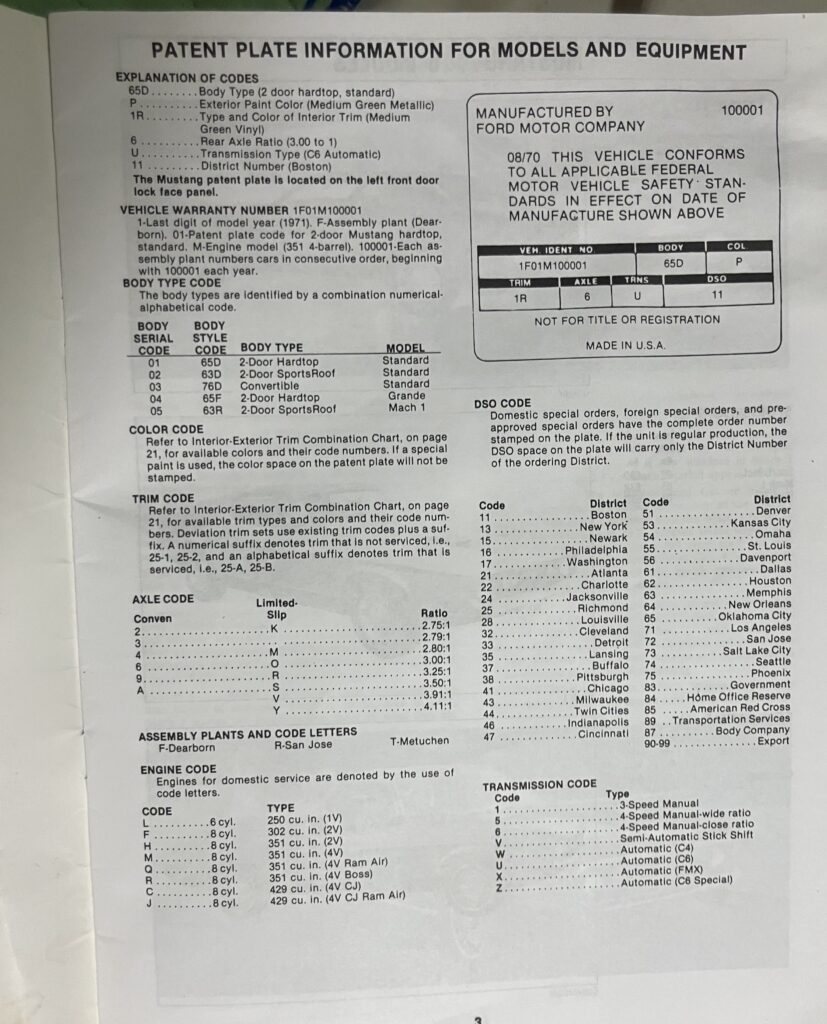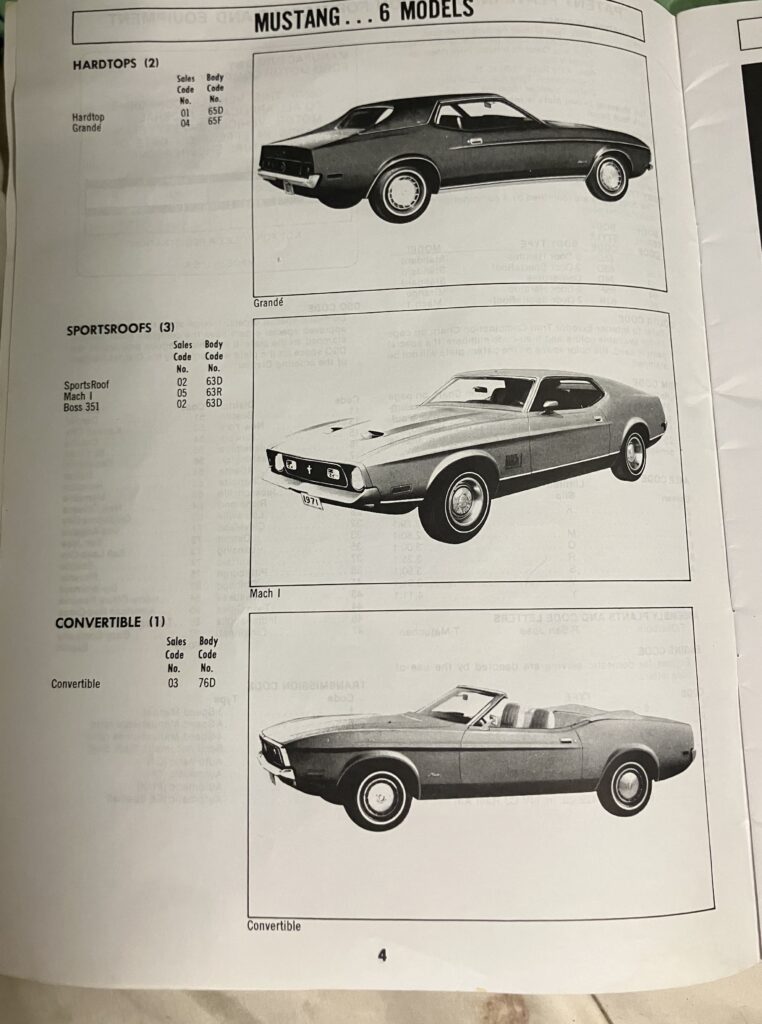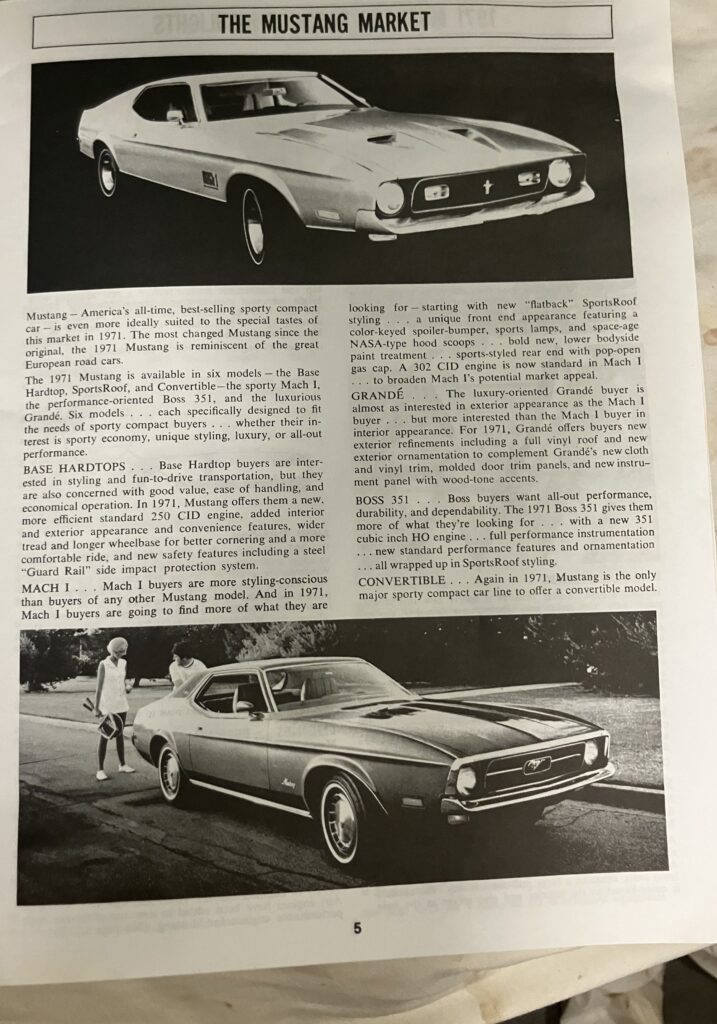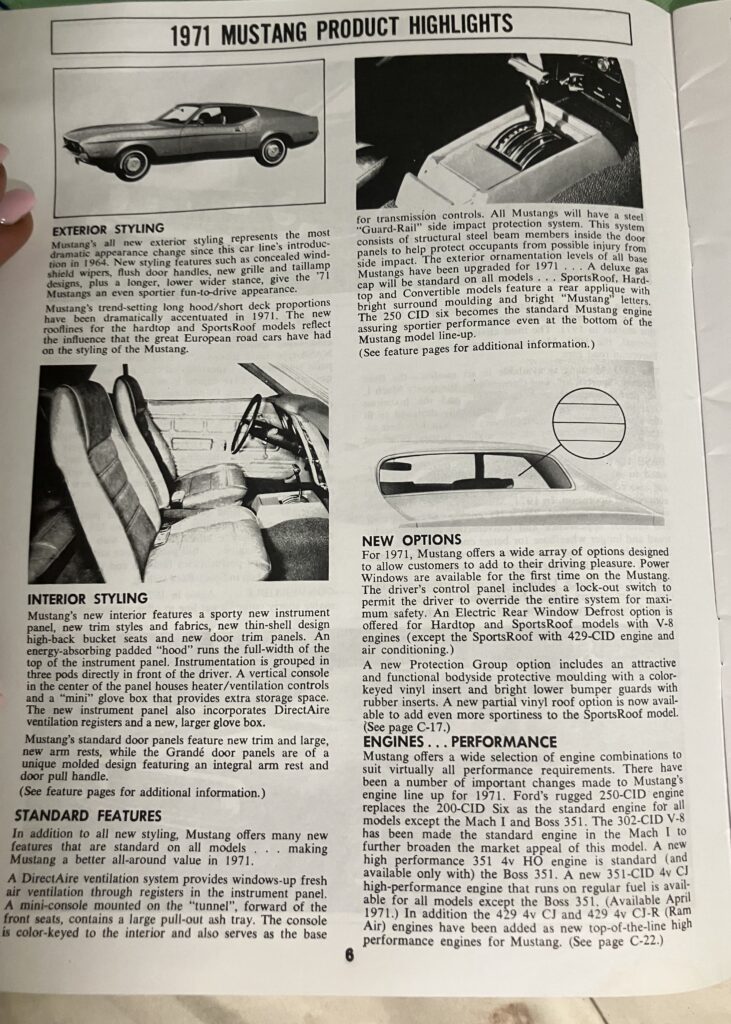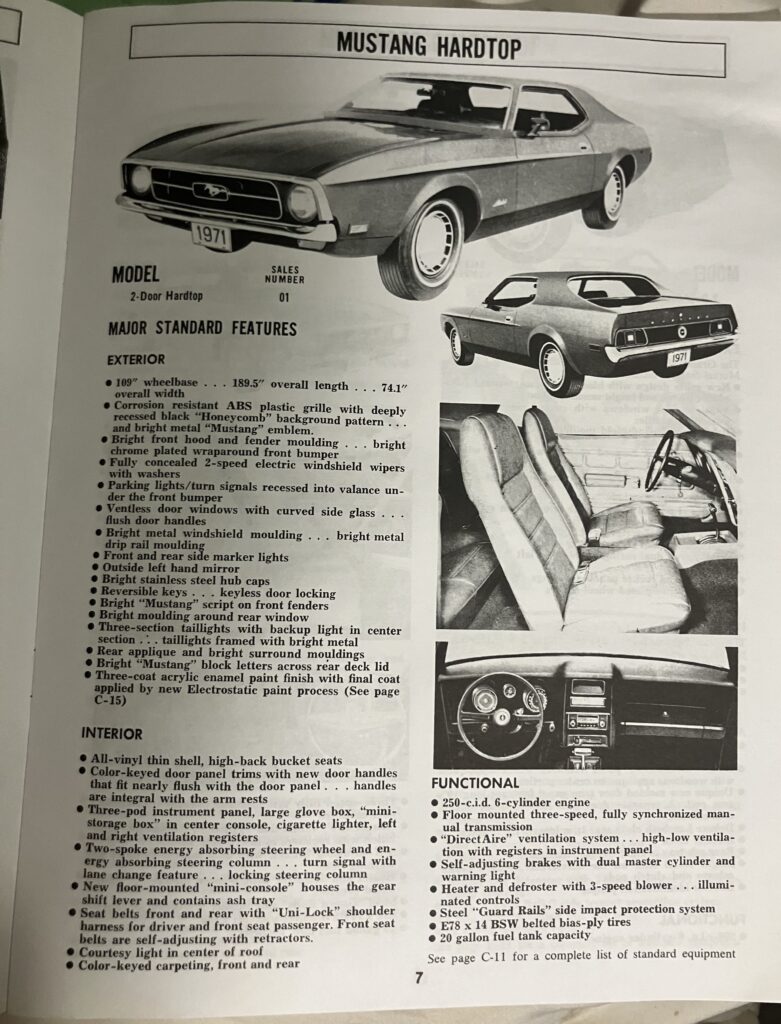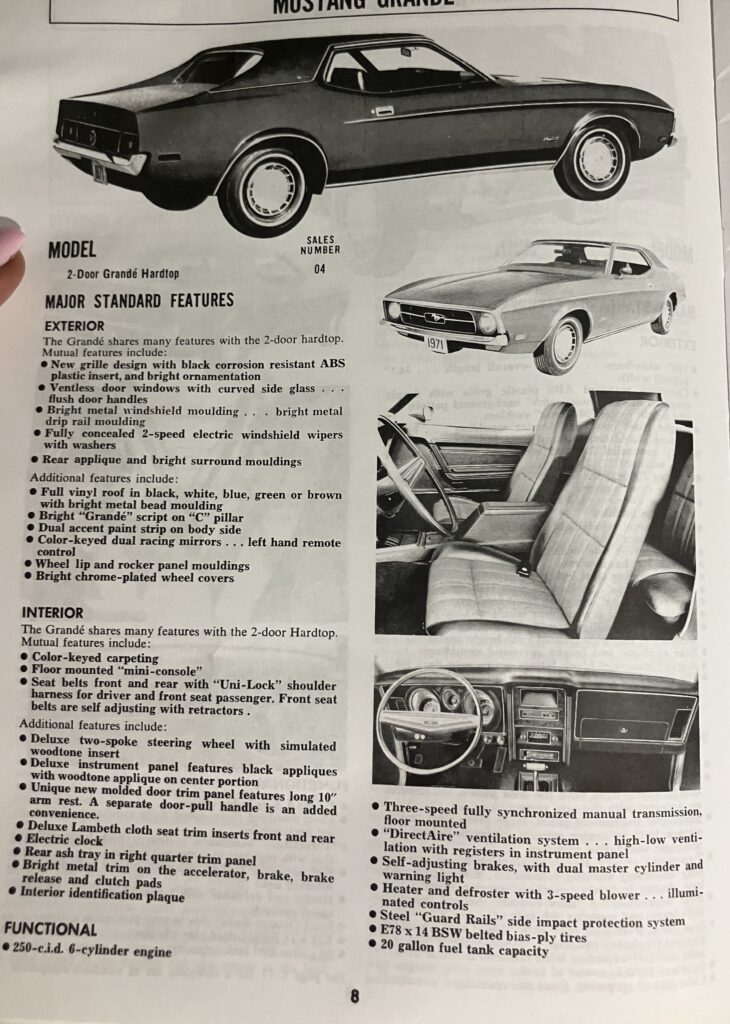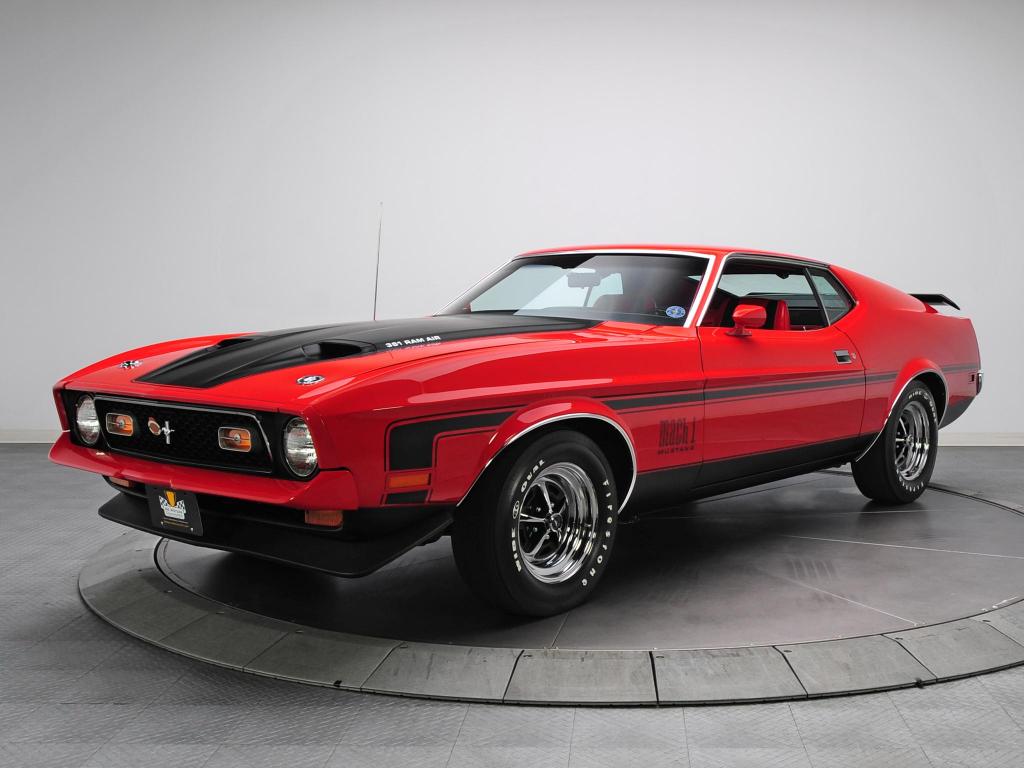
1971 Mustang Mach 1 351 Ram Air
1971 Mustang General Information
The 1971 Mustang became known as the Big Body Mustang! Lee Iacocca once called it a “fat pig”. However the car had to gain width and length to accommodate the new 429 big block being offered in the new 1971 models. Over 400 pounds were added in the course of one year! If you did not order the 429 engine, the smaller engines were quite strained by the increase in weight and size.
The rear window sloped at a very low angle so rear window slats were no longer offered. Probably because if you put slats on the rear window your view would be blocked. Also, because you set low in the seats, it was hard to see over the Long hood and rear end.
The design was mocked up by Gail Halderman and shown to Ford’s then president “Bunkie” Knudsen in February of 1968. Bunkie liked the design and approved it. Sad news however because of his racing and performance tastes, he was removed from office. It seems like the upper echelon didn’t share his tastes and were caving in to the Mustang II design being readied for 1974.
It seems like the car manufacturers and the government were deciding what we the drivers wanted. Iacocca hated the 1971-73 series cars and was eager to build the smaller underpowered cars of the 1974 – 83 era.
Two new options were introduced in 1971. Power windows and rear window defroster were offered. The deluxe interior on the Mach 1 was not standard this year. If you wanted the upgrade, you had to buy it at a price of about $130. The Ram air hood was a no cost option on the 302-2V Mach and standard on the 351-2V and up. The only way to get the hood locks from the factory was to order Ram Air, which was available on 351-4V and up engines. If you ordered the top of the line 429 ram air package, you got the functional hood scoops, all others got a simulated hood scoop. Functional scoops were also offered as on option with the 351 engine.
A competition suspension was available to all cars except ones with the 250 cid 6 Cylinder. It came standard on all Mach 1’s. This package consisted of: heavy duty shock absorbers, Heavy duty springs as well as front and if the engine was a 351 4v or large also rear stabilizer bars and staggered shocks. The cars were also equipped with a variable ratio (15.7 to 1) power steering unit.
1971 Mustang Production Data
Body Style # Produced
63D 2 Door Fastback 23,956
65D 2 Door Hardtop 65,696
76D Convertible 6,121
63F Mach 1 36,499
65F 2 Door Grande 17,406
Total 149,678
Here is a site with a lot of the codes, colors and how to read your vin.
The 1971 Boss 351
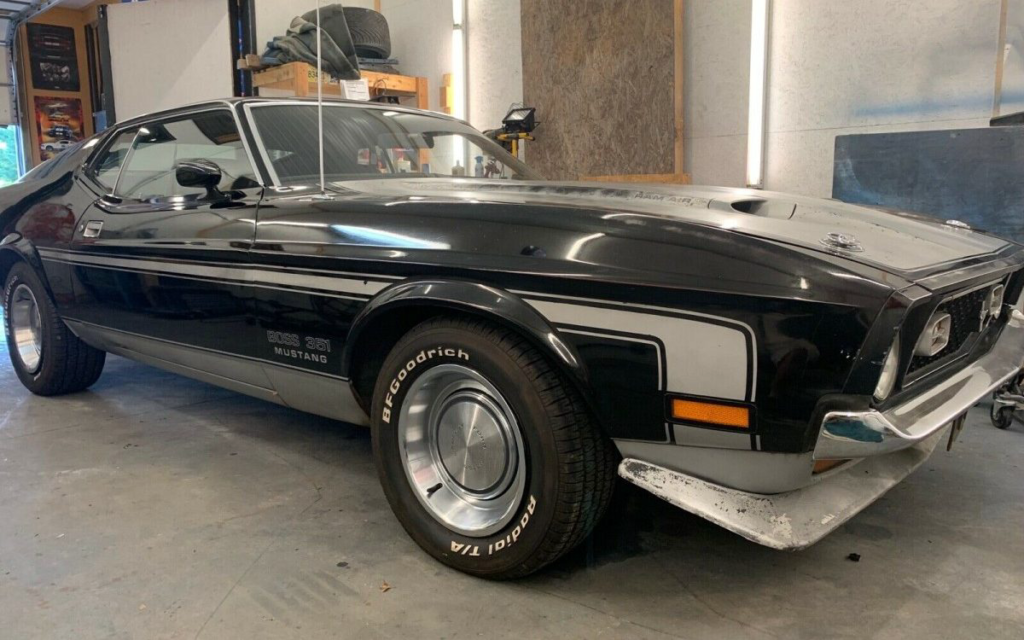
The 1971 Boss 351 replaced the previous Bosses and became known as the performance Mustang. There were 1,806 of these special cars made. They came with very few options, including:
- Boss engine,
- ram air,
- 3.91 rear axle,
- traction-loc,
- 4 speed manual transmission,
- competition suspension,
- Front power disc brakes
- Front spoiler,
- Mach 1 front grill
- Mach 1 lower body side paint
- 351 decals and tape treatment,
- Chrome front bumper
- Hood that was mostly blacked out.
- 15×7 wheels and chrome trim rings
- Goodyear F60x15 RWL tires
The original Boss of 1969-70, the Boss 302, was a homologation model, produced to meet the eligibility requirements of the SCCA Trans-Am series. It used a high-revving 302-cid V-8 rated at 290 horsepower, built to meet the race series’ five-liter class limit.
Ford, however, had ended its Trans-Am program by the time the bigger, heavier Boss 351 arrived late in the 1971 model year. Though it lacked a racing pedigree, the new Boss turned out to be one of the fastest Mustangs of the day. It was also one of the rarest, with just 1,806 built.
“The Boss 351 was more drag-racing oriented than the Boss 302, but better handling than the 429 Cobra Jet,” said Mike Berardi, global director of service engineering operations at Ford Motor. A red Boss 351 is one of 55 Mustangs in his collection, and a favorite to drive. “It’s high revving, so you row the gears more than with a 429 CJ,” he said.
The 351 in the ’71 Boss was Ford’s 351-cid Cleveland engine, nicknamed for the Ohio plant that built it. The 351C shared little more than bore and stroke spacing dimensions with the 351 Windsor used in the 1969 Mustang. Its advantage was deeper breathing, a result of huge ports and valves in the cylinder heads. The 1969-70 Boss 302 had married the Windsor block with Cleveland heads, but the Boss 351 was the whole deal, with lots more torque.
Starting with the 11:1-compression 351C with four-barrel carburetor, Ford assembled a hot rodder’s wish list: four-bolt mains; forged pistons; shot-peened connecting rods; high-lift camshaft; aluminum intake with 750-cfm carburetor; dual-point ignition and ram air induction. It added up to 330 horsepower at 5,400 rpm and 370 pound-feet of torque at 4,000 rpm, matching Chevy’s LT-1 350 in the 1971 Camaro Z28. Magazines that tested the Boss 351 posted quarter-mile times in the low-14-second range at about 100 mph, on par with big-block models like the Mustang 429 CJ.
Boss 351 Brochure provided by 1971 – 1972 Mustang Wiki
Mustang Hardtop
Model 65 D – Mustang Hardtop – Standard equipment on base Mustangs included color keyed nylon carpeting1 floor-shift; high-back bucket seats; steel guardrail door construction; DirectAire ventilation system; concealed windshield wipers with cowl air inlets; mini console with ashtray: armrests; courtesy lights; cigar lighter; heater and defroster; all-vinyl interior; glove box; E78-14 belted black sidewall tires; power convertible top; and either the 250 CID six or 302 CID V-8.
Mustang Fastback
Model 63 D – Standard equipment on base Mustang Fastback (SportsRoof) included color keyed nylon carpeting1 floor-shift; high-back bucket seats; steel guardrail door construction; DirectAire ventilation system; concealed windshield wipers with cowl air inlets; mini console with ashtray: armrests; courtesy lights; cigar lighter; heater and defroster; all-vinyl interior; glove box; E78-14 belted black sidewall tires; power convertible top; and either the 250 CID six or 302 CID V-8.
Mustang Convertible
Model 76 D – Standard equipment on base Mustang Convertible included color keyed nylon carpeting1 floor-shift; high-back bucket seats; steel guardrail door construction; DirectAire ventilation system; concealed windshield wipers with cowl air inlets; mini console with ashtray: armrests; courtesy lights; cigar lighter; heater and defroster; all-vinyl interior; glove box; E78-14 belted black sidewall tires; power convertible top; and either the 250 CID six or 302 CID V-8.
In addition to Hardtop features listed: 5-ply manually operated vinyl top, clear vinyl backlite, color-keyed boot, easy action top fastening latches, full-width rear seat, courtesy lights under instrument panel, glove compartment lock, and wheel covers.
NOTE: There were no special models of the Convertible, however it could be optioned to include even the 429 CID V-8.
Mustang Mach 1 Fastback
Mustang Mach 1 Model 63 R – The Mustang Mach I had all of the basic equipment, plus color-keyed spoiler; hood moldings; fender moldings; and racing mirrors; a unique grille with Sport lamps; competition suspension; trim rings and hubcaps; high-back bucket seats; honeycomb texture back panel applique; pop open gas cap; deck lid paint stripe; black or Argent Silver finish on lower body-sides (with bright molding at upper edge); E70 x 14 whitewalls; and the two-barrel 302 CID V-8. A NASA styled hood scoop treatment was a no-cost option.
Mustang Grande Hardtop
Mustang Grande Hardtop Model 65 F – The Mustang Grande coupe had the same basic features, plus bright pedal pads; Deluxe high-back bucket seats in cloth trim; Deluxe instrument panel; Deluxe two-spoke steering wheel; electric clock; molded trim panels with integral pull handles and armrests; right rear quarter panel trim with ashtray; dual paint accent stripes; dual color-keyed racing mirrors (left remote-control); rocker panel moldings; vinyl roof; wheel covers; and wheel lip moldings.
Mustang Boss 351 Fastback
Mustang Boss 351 Model 63 – The Mustang Boss 351 had even more extras. In addition to the basic equipment, this model featured a functional NASA hood scoop; black or Argent Silver painted hood; hood lock pins; Ram-Air engine call-outs; color-keyed racing mirrors (left remote-controlled); unique grille with Sports lamps; hubcaps with trim rings; body-side tape stripes in black or Argent Silver; color-keyed hood and front fender moldings; Boss 351 call-out nomenclature; dual exhausts; power disc brakes; Space Saver spare tire; competition suspension with staggered rear shocks; 3.91:1 rear axle gear ratio with Traction-lock differential; electronic rpm limiter; functional front spoiler (finished in black and shipped ‘knocked-down’); 80 ampere battery; Instrumentation Group; F60-15 AWL tires; 330 hp High-Output 351 CID V-8 with four-barrel Carburetor; special cooling package; and wide ratio four-speed manual gearbox with Hurst shifter.
145 HP 250 CID I-6
Optional Inline Six. Overhead valves. Cast iron block. Seven main bearings.
Displacement: 250 CID.
Bore and stroke: 3,62″ x 3.19″.
Compression ratio: 9.0:1.
Horsepower: 145 @ 4000 RPM.
Torque: 232 @ 1600 RPM.
Valve lifters: Hydraulic.
Camshaft duration: Intake: 252°, Exhaust: 254°, Overlap: 35°. Lift: (Intake) 0.368″, (Exhaust) 0.368″.
Carburetor: Carter one-barrel (Manual Transmission) D1DZ-9510-HA; California D1DZ-9510-LA (Automatic Transmission) Model D1DZ-9510-KA; California D1DZ-9510-NA.
NOTE: Not available on Mach 1 or Boss 351.
210 HP 302 CID
Optional Two Barrel 302 CID V-8. (Code “C”) Overhead valves. Cast iron block. Five main bearings.
Displacement: 302 cubic inches.
Bore and stroke: 4.00 x 3.00 inches.
Compression ratio: 9.5:1.
Horsepower: 210 @ 4600 RPM.
Torque: 296 @ 2600 RPM
Valve lifters: Hydraulic.
Camshaft duration: Intake: 266°, Exhaust: 244°, Overlap 36°, Lift: (Intake) 0.368″, (Exhaust) 0.380″.
Carburetor: (Manual Transmission) Ford Autolite 2-barrel Model D1OF-9510-ABA; (Auto Transmission) Ford Autolite 2-barrel D1DF-9510-DA; with air conditioning (automatic transmission) Ford Autolite 2-barrel Model D1ZF-9510-AA.
NOTE: Not available on Boss 351, base on Mach 1.
240 HP 351 Cleveland
Optional 240 HP 351 CID Cleveland V-8. Overhead valves. Cast iron block. Five main bearings.
Displacement: 351 cubic inches.
Bore and stroke: 4.00 x 3.50 inches.
Compression ratio: 9.0:1.
Horsepower: 240 @ 4600 RPM.
Torque: 350 @ 2600 RPM.
Valve lifters: Hydraulic.
Camshaft Duration: Intake: 258°, Exhaust: 266°, Overlap 32°, Lift: (Intake) 0.400″ (exhaust) 0.400″.
Carburetor: Ford Autolite 2-barrel Model (manual transmission) D1OF-9510-ZA (Automatic transmission) D1ZF-9510UA; (California) D1OF-9510YA.
285 HP 351 Cleveland
285 HP Optional 351 CID Cleveland V-8. Overhead valves. Cast iron block. Five main bearings.
Displacement: 351 cubic inches.
Bore and stroke: 4.00 3.50 inches.
Compression ratio: 10.7:1.
Horsepower: 285 @ 5400 RPM.
Torque: 370 3200 RPM.
Valve lifters: Hydraulic.
Camshaft duration: Intake: 268°, Exhaust: 280°, Overlap 37°, Lift: (Intake) 0.430″ (exhaust) 0.450″.
Carburetor: Ford Autolite 4-barrel Model (Manual transmission) D1OF-9510-EA, (Automatic transmission) D1OF-9510-AAA.
NOTE: This engine was offered in standard and Ram Air trim – no changes in power and torque rating in both instances.
280 HP 351 CID Cobra Jet
280 HP 351 CID Cobra Jet V-8. Overhead valves. Cast iron block. Five main bearings.
Displacement: 351 cubic inches.
Bore and stroke: 4.00 3.50 inches.
Compression ratio: 9.0:1. Open chamber heads
Horsepower: 280 @ 5800 RPM.
Torque: 345 @ 3800 RPM.
Valve lifters: Hydraulic.
Camshaft duration: Intake: 270°, Exhaust: 290°, Overlap 46°, Lift: (Intake) 0.480″ (exhaust) 0.488″.
Carburetor: Ford Autolite 4-barrel Model (Manual transmission) D1ZF-9510-FA, (Automatic transmission) D1ZF-9510-GA.
NOTE 1: The “351 Cobra Jet” high-performance engine used a different intake manifold, the high-lift, long-duration camshaft noted above, higher rate valve springs with dampers, a 715-CFM spread-bore 4300-D carburetor and a dual-point distributor (only with four-speed manual transmissions – not sold in California). The block was upgraded to four-bolt main bearing caps, and larger harmonic balancer was installed.
NOTE 2: This engine was offered in standard and Ram Air trim – no changes in power and torque rating in both instances.
330 HP 351 CID Boss 351
330 HP 351 CID Boss 351 V-8. Overhead valves. Cast iron block. Five main bearings.
Displacement: 351 cubic inches.
Bore and stroke: 4.00 x 3.50 inches.
Compression ratio: 11.0:1.
Horsepower: 300 @ 5400 RPM.
Torque: 370 @ 4000 RPM.
Valve lifters: Mechanical.
Camshaft duration: Intake: 324°, Exhaust: 324° degrees, Overlap 92° Lift: (Intake) 0.491″ @ .020″ lash (Exhaust) 0.491″ @ .020″ lash.
Carburetor: (Manual Transmission only) Ford Autolite Spread bore 4-barrel Model D1ZZ- 9424-G.
370 HP 429 Cobra Jet
370 HP Optional 429 Cobra Jet V-8. Engine Code “Z” Overhead valves. Cast iron block. Five main bearings.
Displacement: 429 cubic inches.
Bore and stroke: 4.362 x 3.950 inches.
Compression ratio: 11.30:1.
Horsepower: 370 @ 5400 RPM.
Torque: 450 @ 3400 RPM.
Valve lifters: Hydraulic.
Camshaft duration: Intake: 282°, Exhaust: 296°, Overlap 58°, Lift: (intake) 0.500″ (exhaust) 0.500″.
Carburetor: GM Rochester Quadra-Jet 4-barrel Model (Manual transmission) D1OF-9510-KA; Automatic transmission) D1OF-9510-AA.
NOTE 1: This engine was offered in standard and Ram Air trim – no changes in power and torque rating in both instances. The engine fitted with or without a standard hood scoop, was matched with a 3.25:1 rear-axle ratio. When fitted with a “shaker” hood scoop, the vehicle received a 3.50:1 rear axle. This year, the Cobra Jet engine also used a four-bolt main block #DOVE-A.
375 HP 429 Super Cobra Jet
375 HP Optional 429 CID Super Cobra Jet V-8. Overhead valves. Cast iron block. Five main bearings.
Displacement: 429 cubic inches.
Bore and stroke: 4.362 x 3.590 inches.
Compression ratio: 11.30:1.
Horsepower: 375 @ 5600 RPM.
Torque: 450 @ 3400 RPM.
Valve lifters: Mechanical.
Camshaft duration: Intake: 300°, Exhaust: 300°, Overlap 72°, Lift: (intake) 0.515″ (exhaust) 0.515″.
Carburetor: Ford Holley 4-barrel Model (Manual transmission) D1OF-9510-SA; (Automatic transmission) D1OF-9510-TA.
NOTE: The 429 Super Cobra Jet was fitted with a Holley 780 CFM Vacuum Secondaries 4-bbl carburetor, aggressive mechanical camshaft, a four-bolt main block, forged pistons, and forged connecting rods. The engine was matched with a 3.91:1 or 4.30:1 rear axle ratio.
1971 Ford Mustang Facts – Chassis Features
Wheelbase: 109.00″
Overall length: 187.5″
Height: (Hardtop) 51.5″ (Fastback} 50.60″ (Mach 1) 50.4″ (Convertible) 51.5″
Weight (assumes base engine, no options):
Hardtop: 3151 lbs.
Grande: 3177 lbs. (incl. Vinyl roof)
Fastback: 3121 lbs.
Mach 1: 3172 lbs.
Boss 351: 3141 lbs.
Convertible: 3273 lbs.
Front tread: 61.50″
Rear tread: 60.00″
1971 Ford Mustang Facts –
Power Trains
Transmission Ratios
Three-Speed Manual Transmission
250 CID I-6, 302 CID V-8: First: 2.99:1, Second: 1.75:1, Third 1:1. Reverse: 3.17:1. Synchromesh all forward gears
351 CID V-8 and 429 CID V-8: First: 2.42:1, Second: 1.61:1, Third 1:1. Reverse: 2.33:1. Synchromesh all forward gears
Four-Speed Manual Transmission
351 CID V-8s First: 2.78:1, Second: 1.93:1, Third 1.36:1, Fourth: 1:1. Reverse: 2.78:1
429 CID V-8 (Optional All 351 CID): First: 2.32:1, Second: 1.69:1, Third: 1.29:1, Fourth: 1:1. Reverse: 2.32:1
Three-Speed Automatic Transmission –
250 CID I-6, and 302 V-8: Low: 2.46:1, Second: 1.46:1, Direct 1.00:1. Reverse: 2.20:1. Max Stall 2.10:1
351 CID 2-barrel V-8: Low: 2.00:1, Second: 1.47:1, Direct 1.00:1. Reverse: 2.20:1. Max Stall 2.05:1
351 CID 4-barrel V-8: Low: 2.46:1, Second: 1.46:1, Direct 1.00:1. Reverse: 2.20:1. Max Stall 2.16:1
429 CID V-8 : Low: 2.46:1, Second: 1.46:1, Direct 1.00:1. Reverse: 2.20:1. Max Stall 2.05:1
NOTE: the 351 and 429 received the stronger C6 transmission, the 351 2-v received the FMX, while the I-6 – 302 V-8 received the C4)
Rear Axle Ratios
250 CID I-6:
Three Speed Manual: 3.00:1 Optional 2.79:1
Automatic: 2.79:1 Optional 3.00:1
302 CID V-8
Three Speed Manual: 3.00:1
Automatic: 2.79:1 Optional 3.00:1
240 HP 351 CID 2V V-8
Three Speed Manual: 2.75:1 Optional 3.00:1, 3.25:1
Automatic: 2.75:1 Optional 2.75:1, 3.25:1
240 HP Ram Air 351 CID V-8
Three Speed Manual: 3.00:1 Optional 3.25:1
Automatic: 3.00:1 Optional 3.25:1
Four Speed Manual: 3.25:1
285 HP 351 CID V-8
Three & Four Speed Manual: 3.25:1
Automatic: 3.00:1 Optional 3.25:1
285 HP Ram Air 351 CID V-8
Three & Four Speed Manual: 3.25:1
Automatic: 3.25:1
280 HP Cobra Jet 351 CID V-8
Four Speed Manual: 3.50:1, Optional: 3.91:1, 4.30:1
Automatic transmission: 3.50:1 Optional: 3.91:1, 4.30:1
330 HP Boss 351 CID V-8
Four Speed Manual: 3.91:1, Optional: 4.30:
370 HP non-Ram Air Cobra Jet 429 CID V-8
Four Speed Manual & Automatic: 3.25:1 , Optional 3.50,
370 HP Ram Air Cobra Jet 429 CID V-8
Four Speed Manual & Automatic: 3.50:1 , A/C 3.25:1.
375 HP Super Cobra Jet Ram Air 429 CID V-8
Four Speed Manual & Automatic: 3.91:1 and/or 4.11:1. (buyer choice)
1971 Ford Mustang Facts – Powertrain Options
Engine
240 hp 351 CID V-8 engine ($45).
285 hp 351 CID ‘Cleveland’ V-8 engine ($93).
370 hp Cobra Jet 429 CID V-8 engine ($372).
NOTE: Boss 351 is a package containing the Boss 351 Engine. The package pushed the price of a base Mustang Fastback to $4,124, meaning the package cost $1,118.
Other Powertrain
Cruise-O-Matic automatic transmission ($217-$238).
Drag-Pac rear axle 3.91:1 ratio ($155); 4.11:1 ratio ($207).
Four-speed manual transmission ($216).
Limited-Slip differential ($48).
1971 Ford Mustang Facts – Significant Options
Air conditioner, Select-Aire not available 429 CID CJ V-8 with four-speed
Backlight, convertible glass
Console
Decor Group, exterior – not available on Mach I and Grande,
Decor Group, Interior – not available on Mach I and Grande ($101), with dual racing mirrors
Decor Group, interior deluxe – Sportsroof and convertible ($133), with dual racing mirrors
Differential, limited slip (Equa-Lock) 250 CID I-6 and 302 V-8
Differential, Traction-Lok NOT available 250 CID I-6 and 302 V-8
Electric clock, standard Mach I and Grande
Left door mirror, remote control
Power disc brakes.
Power steering
Racing mirrors, color-keyed dual – standard in Mach I and Grande,
Radio, AM/FM stereo
Radio, push-button AM
Seat belts, Deluxe with reminder light
Speaker, rear seat – hardtop and Grande only
Speed control, V-8 and automatic transmission required
Steering wheel, Tilt-Away
Stereo-Sonic tape system, AM radio required
Suspension, competition handling, standard Mach I and GT – 429 CID V-8 required,
Suspension, performance handling, not available on Grande or-with six-cylinder and 429 V-8 engines,
Tachometer, V-8s only.
Tinted Windows and windshield.
Vinyl roof, hardtop only.
Wheel covers – not available on Mach I, Boss 351 or Grande, but included with exterior Decor Group.
Wheel covers – not available Mach I or Boss 351; standard on Grande.
Wheels, styled steel – standard on Mach I and Boss 351; not available on Grande.
Wheels, Magnum 500 Chrome.
Windshield wipers, intermittent.
1971 Mustang Illustrated Facts and Specifications Manual
